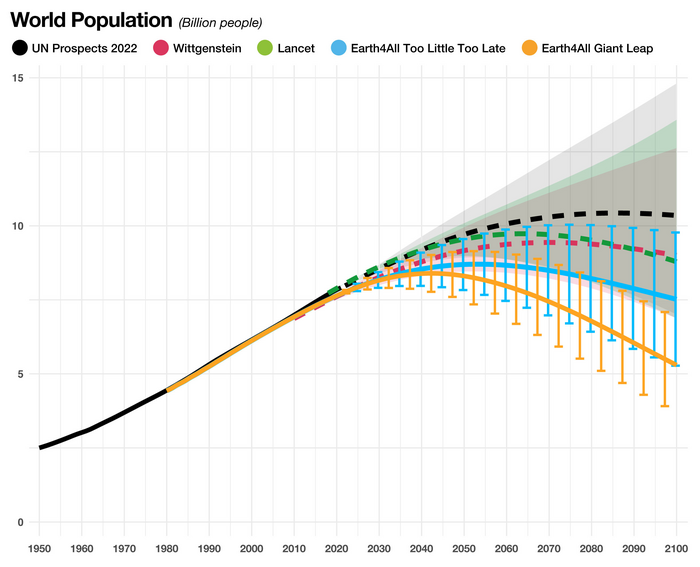Latest research predicts Earth’s population peak
According to a recent analysis, the world’s population is projected to reach its peak of slightly under 9 billion individuals by 2050, after which experts expect it to decline.
For years, experts have debated the exact number of people that Earth can sustain without experiencing negative consequences, such as food shortages, environmental degradation, and a strain on resources.
This prediction depends on several factors, including declining fertility rates, increased access to birth control, and improved healthcare and education.
Some have argued that we have already exceeded the planet’s carrying capacity, while others believe that technological advancements can continue to support a growing population.
The latest forecast represents a considerable reduction from various notable population projections, including those made by the United Nations.
Projections of the Earth’s Population

Photo credit: Earth4All
The analysts proposed that if the global community made significant investments in economic advancement, education, and healthcare, the world’s population could reach 8.5 billion by the mid-point of the 21st century.
In addition to declining fertility rates, advancements in healthcare and medicine contribute to a longer lifespan. This leads to an aging population.
While this can lead to new challenges, such as an increased burden on healthcare systems and pension plans, it also means that fewer people are dying prematurely from preventable diseases.
The published paper is titled “People and Planet: 21st Century Sustainable Population Scenarios and Possible Living Standards Within Planetary Boundaries.” The Earth4All initiative for the Global Challenges Foundation has released new projections.
You may also like: Elon Musk called ‘space Karen’ in a projection at Twitter headquarters
The team utilized a novel system dynamics model called Earth4All. They aim to investigate two possible scenarios for the remainder of the century.
There are more people on Earth than ever, but that disguises a new reality. This century, we could hit a peak and begin to decline https://t.co/cCJFbWZsp0
— National Geographic (@NatGeo) March 21, 2023
In the first scenario, referred to as “Too Little Too Late,” global economic development continues on a trajectory similar to the past 50 years.
Numerous countries that are currently impoverished have broken free from extreme poverty.
In this situation, the researchers estimated that the world’s population will reach a peak of 8.6 billion individuals in 2050 before decreasing to 7 billion by 2100.
In the second scenario, known as the “Giant Leap,” the analysts predicted that the global population would top out at 8.5 billion people around 2040. Then, it will drop to roughly 6 billion by the end of the century.
Making excellent investments in poverty alleviation can make this remarkable outcome achievable. Particularly in education and healthcare, and by instituting exceptional policy turnarounds on food and energy security, inequality, and gender equity.
In this scenario, extreme poverty is eradicated within a single generation (by 2060), substantially impacting global population trends.
The Experts’ Insights
According to the authors, many notable population projections neglect to emphasize the significance of swift economic advancement.
Per Espen Stoknes, the Earth4All project leader and director of the Center for Sustainability at the Norwegian Business School stated.
“We recognize that rapid economic development in low-income countries has an enormous influence on fertility rates. As girls gain access to education and women achieve economic empowerment and improved healthcare, fertility rates decrease.”
Beniamino Callegari is an Associate Professor at Kristiania University College and a member of the Earth4All modeling team.
He noted that only a few significant models account for population growth, economic development, and their interconnections simultaneously.
Countries with the Most Population Growth
The study focused on ten global regions, including sub-Saharan Africa, China, and the United States.
Presently, population growth is at its highest in several African nations. These include Angola, Niger, the Democratic Republic of Congo, and Nigeria, as well as Asian countries like Afghanistan.
Related Articles
Why are billionaires Elon Musk, Mark Andreesen concerned about birth rates?
Scientists Discover Molecule that Could Have Started Life on Earth
Callegari explained, “Assuming that these nations implement successful policies for economic advancement, we can anticipate that the population will peak sooner rather than later.”
Of course, population projections are just that — projections. Many factors could affect the outcome, such as changes in government policies, natural disasters, and unforeseen technological advancements.
Additionally, while the overall population may peak, some regions may continue to experience rapid growth.







